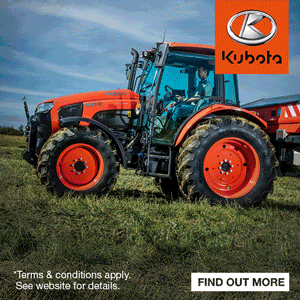Product Review: Land Rover Defender Commercial
28th February 2023
There are plenty of options for those looking for commercial vehicles that will spend their lives on the road, but choice is more limited when it comes to vehicles with the off-road capabilities needed for a typical farm. David Williams borrowed the latest Land Rover Defender Commercial for a week-long test.
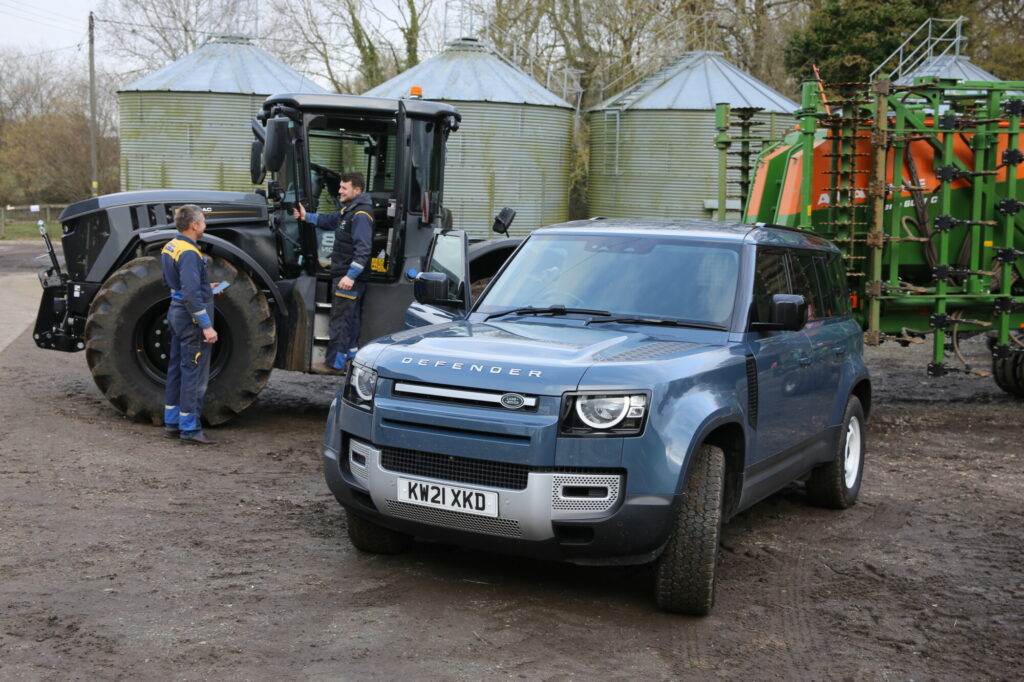
Limited options for farms
During the past decade, the number of options in terms of 4×4 commercial-type vehicles suitable for farms has dwindled. Several panel van manufacturers offer 4wd as an option, but when it comes to vehicles with extra ground clearance and true off-road capability suitable for transporting tools and parts to machines broken down away from the yard there are few to choose from.
Premium solution
 The Defender commercial, designated Hard Top, is available in short (90) and long (110) wheelbase models and with a choice of engines. Both models are available in a range of equipment levels, starting with the base Hard Top, then the Hard Top S, SE, HSE, X-Dynamic HSE or X variants. The D250 power unit with 249hp and 570Nm of torque is fitted in Standard, S and SE variants, and the D300 engine with 300hp and a massive 650Nm of torque powers X-Dynamic HSE and X models. All engines are mild hybrid, which means they won’t run on a battery alone, but electric drive assistance during acceleration helps reduce fuel consumption and emissions.
The Defender commercial, designated Hard Top, is available in short (90) and long (110) wheelbase models and with a choice of engines. Both models are available in a range of equipment levels, starting with the base Hard Top, then the Hard Top S, SE, HSE, X-Dynamic HSE or X variants. The D250 power unit with 249hp and 570Nm of torque is fitted in Standard, S and SE variants, and the D300 engine with 300hp and a massive 650Nm of torque powers X-Dynamic HSE and X models. All engines are mild hybrid, which means they won’t run on a battery alone, but electric drive assistance during acceleration helps reduce fuel consumption and emissions.
Automatic eight=speed transmission with manual override is standard, and a mechanical two-speed transfer box provides a manually selected low range for extreme off-road situations.
The model supplied for the Farmers Guide test was the Defender 110 D250 in the mid-spec S trim level.
Land Rover Defender 110 Commercial D250
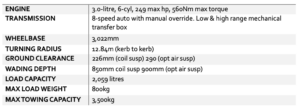
Practicality
A full-height mesh bulkhead behind the front seats ensures the driver, passengers and load remain separate even during heavy braking. The Hard Top version is based firmly on the standard model, but the rear windows are replaced by solid panels, the rear seats have been removed and replaced by a full-length, flat floor, and space that would have accommodated the passengers’ legs has been cleverly converted to underfloor storage.
The long wheelbase (five-door) version tested retains its two rear passenger side doors, and these add convenience for loading.
Total load volume is impressive, at 2,059 litres. The lockable storage under the floor adds 58 litres just inside the rear door, and 155 litres behind the front seats. Opening the rear side doors exposes horizontal hatches which provide access to the underfloor storage even when the load area floor is completely covered.
Access to the rear load area is less convenient than it would be for a large panel van, as the doors were shaped for passenger use rather than for loading bulky items.
The rear door is 90cm high, and the opening width is between 96 and 106cm. The single-piece door has side hinges and opens easily. The side hinged opening means it is easy to stand at the rear and reach loads inside by hand, or using a forklift, but opening the door fully requires a lot of clearance.
With standard coil spring suspension the ride height is fixed, and the load floor is 83cm above ground level at the rear, and 92cm through the side doors.
The internal load area is 147cm long, and 146cm wide just behind the bulkhead at floor level, increasing to 152cm wide higher up, At the rear, just inside the rear door the usable width is 111cm.
There are four hefty tie-down points.
Towing capacity is 3,500kg, even with the maximum 818kg payload.
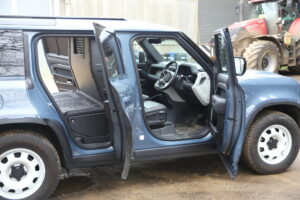
The test vehicle was equipped with an optional third centre seat. Space is tight when transporting three adults, but it is reasonably comfortable for shorter journeys.
Comfort and controls
The Defender Hard Top comes standard with just two front seats, but the test vehicle also had the optional third seat between the two standard seats. The seats are all comfortable, although the centre seat is slightly higher. When carrying three adults the cab is quite cosy, and the huge number of grab handles is a help when travelling over uneven ground. For shorter journeys the accommodation is adequate, and being able to occasionally carry three people will be an advantage for most farms and contracting businesses. When the centre seat isn’t needed it can be folded to create a flat space suitable for resting a laptop, and it also contains two large cup holders. It is a very practical design.
Like passenger versions, all the main controls are dashboard mounted – including the gear selector. Gear lever positions in auto mode are Reverse, Neutral, Drive and Park. Manual gear shifting is available by pushing the gear stick to the left and then pushing it forward or pulling it back. There are no steering wheel paddles.
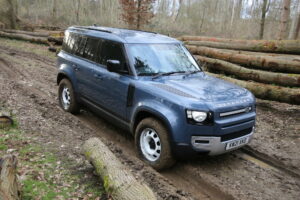
Heavily rutted woodland tracks and muddy fields were no problem for the capable off-roader.
Superb off-road
All Defenders come with Terrain Response. This allows the driver to select drive characteristics to match the terrain using a rotary dial which doubles as the driver’s side temperature control. Options include Eco, Comfort, Grass/gravel/snow, Mud ruts, Sand and Rock Crawl. A separate button selects low range which reduces the gear ratios considerably, but the vehicle must be stationary.
The test week included an opportunity to try the Defender in demanding off-road conditions in woodland. Forestry machinery had created deep ruts, and the heavy, wet ground was extremely slippery. Even so, the Defender coped perfectly well in the standard road driving modes, although when the Mud ruts mode was selected there was noticeably more traction as the differentials locked, and the vehicle felt more capable. The powerful engine was superb – and the huge amount of torque produced meant that the Defender maintained constant low speeds as conditions varied easily, at just over an idle.
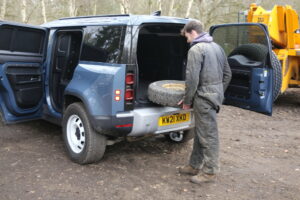
The Defender 110 Hard Top is ideal for transporting tools and equipment around the farm but has a high price tag.
Performance and handling
On the road, the large Defender also handles well. The suspension is very firm but comfortable and there is little body roll when cornering. The big engine is smooth and exceptionally quiet, and there is very little wind noise contributing to a high level of comfort during longer journeys.
Official acceleration figures include a 0–60mph time of just 7.9 seconds, and a maximum speed of 117mph.
The test week included a wide range of driving situations from motorway use to the woodland tracks, and average fuel consumption was 28.5mpg. Where permitted – 70mph is achieved at approximately 1,500rpm, and on a longer journey the Defender achieved almost 38mpg.
Ease of use
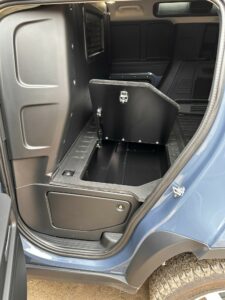 All-around vision is excellent. The external mirrors provide a clear view down the sides, and the test vehicle also had the optional ClearSight internal mirror. The view through a conventional mirror would be partially obstructed by the full-height mesh bulkhead as well as loads in the rear, but the ClearSight mirror is a screen which displays an image from a camera at the back of the vehicle. It works well and improves safety when manoeuvring in tight spaces. The S-specification also includes a 3d surround view displayed on the dashboard screen. This highlights obstructions close to the car and contributes to safe manoeuvring.
All-around vision is excellent. The external mirrors provide a clear view down the sides, and the test vehicle also had the optional ClearSight internal mirror. The view through a conventional mirror would be partially obstructed by the full-height mesh bulkhead as well as loads in the rear, but the ClearSight mirror is a screen which displays an image from a camera at the back of the vehicle. It works well and improves safety when manoeuvring in tight spaces. The S-specification also includes a 3d surround view displayed on the dashboard screen. This highlights obstructions close to the car and contributes to safe manoeuvring.
The 10in touchscreen is clear and easy to use. The menus are logical, and it takes little time to get used to the functions. Apple CarPlay and Android Auto compatibility is standard. The navigation system is the same as in standard passenger variants and it is easy to set up and use.
All new Defenders come with plenty of storage for odds and ends. This includes large door pockets, trays of various sizes in the dashboard, plus a reasonable size glovebox.
Land Rover Defender Commercial: The verdict
For those needing a commercial vehicle that can carry up to three passengers in comfort, perform exceptionally well off-road, and pull large trailers, the Defender 110 D250 Hard Top is hard to beat. However, the attractive package comes with a relatively high price tag. The standard model costs approximately £47,450 + VAT and upgrading to the S specification tested adds approximately £2,860 + VAT. Additional options fitted to the test car included an electric folding towbar, the ClearView rear mirror, a Tracker, an electronic active differential, the centre front seat, metallic blue paint and off-road tyres which added a further £4,500.
